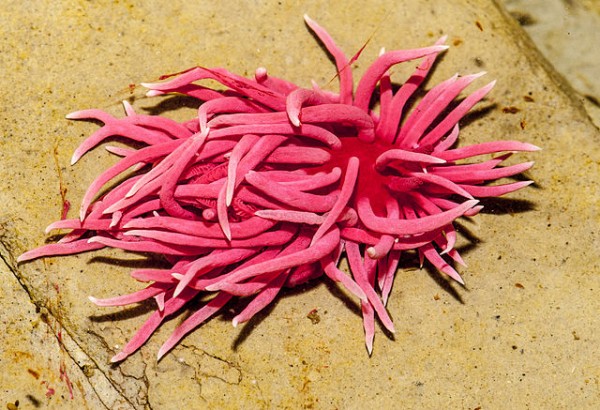Warm Ocean Currents Bring Massive Sea Slug Population
| Marco Foronda | | Jan 31, 2015 06:32 AM EST |
(Photo : wikipedia.org) Okenia rosacea is a species of sea slug.
Tide pools along the coast of central and northern California are filling up with inch-long, pink Hopkins' rose nudibranch, a sea slug whose vivid coloring gives it a kind of punk rock appeal.
Colder currents likely are limiting the southern sea slug's range because their prey lives along the Pacific Coast up to British Columbia, believe a team of researchers from UC Santa Cruz's Institute of Marine Sciences, UC Santa Barbara's Marine Science Institute, the California Academy of Sciences and University of Zadar, Croatia believe.
Like Us on Facebook
The Hopkins' rose nudibranch gets its pink pigmentation by eating a rose-colored encrusting bryozoan, which is a moss-like species.
Researchers added that warmer ocean temperatures triggered a population explosion of the Hopkins' rose nudibranch beyond its normal Southern California range.
The brilliant pink sea slug is uncommon north of San Luis Obispo and even rarer north of San Francisco. Scientists in Santa Cruz, San Francisco and Bodega Bay have spotted the tiny puffs concentrating in tide pools as far north as Humboldt County.
The sea slugs haven't been seen in such numbers in the colder parts of California since 1998.
Now, northward and onshore currents are carrying the slug's larvae to tide pools and they aren't being washed away by upwelling.
"The nudibranch can just crawl short distances and don't live very long," said Jeff Goddard, a scientist at UC Santa Barbara's Marine Science Institute, so they're useful in monitoring quick changes in ocean conditions.
"There are some detrimental impacts to the ecosystem," Goddard said. "Higher temperature often means the water is less productive."
TagsOcean, sea slug, pink Hopkins’ rose nudibranch, rose nudibranch, warm ocean
©2015 Chinatopix All rights reserved. Do not reproduce without permission
EDITOR'S PICKS
-

Did the Trump administration just announce plans for a trade war with ‘hostile’ China and Russia?
-

US Senate passes Taiwan travel bill slammed by China
-

As Yan Sihong’s family grieves, here are other Chinese students who went missing abroad. Some have never been found
-

Beijing blasts Western critics who ‘smear China’ with the term sharp power
-

China Envoy Seeks to Defuse Tensions With U.S. as a Trade War Brews
-

Singapore's Deputy PM Provides Bitcoin Vote of Confidence Amid China's Blanket Bans
-

China warns investors over risks in overseas virtual currency trading
-

Chinese government most trustworthy: survey
-

Kashima Antlers On Course For Back-To-Back Titles
MOST POPULAR
LATEST NEWS
Zhou Yongkang: China's Former Security Chief Sentenced to Life in Prison

China's former Chief of the Ministry of Public Security, Zhou Yongkang, has been given a life sentence after he was found guilty of abusing his office, bribery and deliberately ... Full Article
TRENDING STORY

China Pork Prices Expected to Stabilize As The Supplies Recover

Elephone P9000 Smartphone is now on Sale on Amazon India

There's a Big Chance Cliffhangers Won't Still Be Resolved When Grey's Anatomy Season 13 Returns

Supreme Court Ruled on Samsung vs Apple Dispute for Patent Infringement

Microsoft Surface Pro 5 Rumors and Release Date: What is the Latest?










